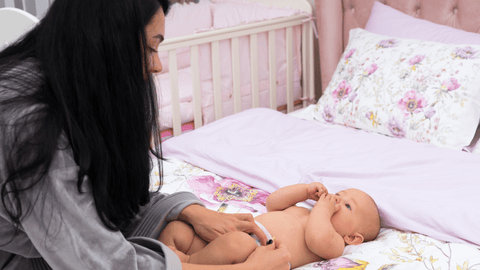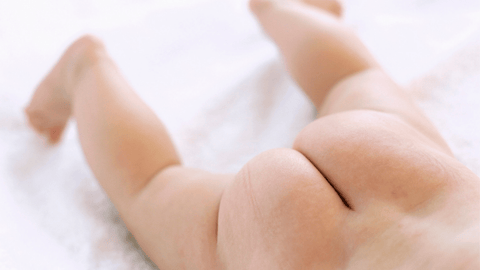Of course, it's natural to worry when you notice a red rash developing on your baby's bum.
Nappy rash is actually a very common type of skin irritation experienced by almost all babies and occurs with both disposable nappies and reusable ones.
The good news is though this can be easily treated and prevented.
Do Cloth Nappies Cause Nappy Rash?
No!
In fact, a study published in the British Journal of General Practice found that babies in disposable nappies are just as likely to get nappy rash as those in cloth nappies.
Some people claim that cloth nappies or reusable nappies are more likely to cause nappy rash.
However, this is more likely a result of infrequent changes.
Disposable nappies, on the other hand, are full of chemicals that can actually be irritating to your babies' sensitive skin.
How to Spot Nappy Rash
You'll probably know it when you see it, but here are the symptoms of nappy rash just in case.
Nappy rash tends to show up as redness, tenderness, and prickly red bumps.
This is a result of the ammonia in urine or bacteria in poop that burns and irritates your baby's bottom.
If it gets worse, it can even result in sores on the skin.
You may also notice that your baby seems uncomfortable and tends to fuss when you touch their nappy area during nappy changes or bath time.

Possible Causes of Nappy Rash
If it’s not cloth nappies causing rashes, then what is it?
Well, there are a variety of possible causes that can result in the little red bumps on baby’s bottoms.
The most common cause of nappy rash is irritation from urine and poop which has the potential to cause a bacterial infection.
If you leave your baby in a wet nappy for too long, the moisture can soften and weaken the outer layer of their skin.
When your baby poops, the bacteria reacts with urine in the nappy to create ammonia, which can burn their skin or make it red and sore.
A separate cause of redness on baby's skin includes thrush, a fungal infection, which is an overgrowth of yeast.
Or, your baby may just have an allergic reaction to certain products, known as contact dermatitis.
Finally, food allergies can also cause nappy rash.
Our Top 4 Tips In Preventing Nappy Rash
Here’s how to avoid nappy rash when you’re using cloth nappies and some treatment tips if it occurs.
1. Change Nappies Frequently
Check your newborn baby for wetness every hour and older babies every two hours. This will ensure your baby's skin is dry and keep them from sitting in wetness. It will reduce the chances of urine and poop sharing the nappy and creating a burning chemical reaction.
Some brands of cloth nappies can be less absorbent than disposables, you will need to change nappies more frequently to keep your baby from sitting in wetness.
When changing, make sure you clean the entire nappy area, including the waist and tops of the legs.
You also want to make sure your baby's skin is completely dry before putting on a new nappy and the option presents you can give their bottoms a bit of time to breathe.
Use moisture-wicking liners in cloth nappies so your baby’s skin will stay dry longer.
This is especially useful overnight when you don’t want to get up every house for a nappy change.
2. Avoid Irritating Baby Products
Disposable wipes with alcohol or fragrances can be irritating to baby’s skin and contribute to nappy rash.
Instead, use cloth wipes moistened with water. This is also more economical than disposable wipes and will help save you money in the long run!
Washing nappies in chemical-laden detergent can cause nappy rash if your baby is allergic to certain fragrances and additives.
Plus, regular detergent can leave a residue in cloth nappies and decrease their efficacy at absorbing liquids.
As an alternative, use nappy-safe detergents that don't stay in the cloth fibers and won't irritate your baby's skin.
3. Clean Nappies Properly
You should aim to wash your nappies at least every 2 days so that any bacteria doesn't get a chance to thrive and multiply.
If your nappies aren't washed in 60-degree water, then bacteria in the nappies may still be alive.
Make sure you remove solids before the nappies go in the wash, and give them a pre-rinse in warm water without detergent before their hot cycle.
You can even implement these steps if your inserts start to feel build-up from the detergents.
I would recommend implementing this every couple of months when you need to do a freshen-up. It will help bring them all back to nearly brand new.
Step 1 - Grab yourself Canesten Hygiene Laundry Rinse or Dettol Laundry Sanitiser (both are available at your local supermarket)
Step 2 - Soak your inserts in a bucket of hot water for 30 minutes with a drop of dishwashing liquid.
Step 3 - Once they have finished soaking, add them in to the wash with the laundry sanitizer. Be sure to check the water temperature is set to 60 degrees or below.
4. Use A Good Quality Cloth Nappy Fabrics to Prevent Rash
If you have a baby that’s just extra sensitive to wetness and they seem to get a rash no matter what you do, try out some different nappy fabrics.
Nappies with stay-dry layers, such as fleece or suede cloth, can wick moisture from baby's skin into the absorbent layer of the nappy.
Our bamboo booster set is a natural product that is super absorbent, making it a great choice for reusable nappies.
Avoid using microfiber directly against your baby's skin since this can be overly drying and cause further irritation.
Microfibre is a good choice in pocket nappies since it’s extremely absorbent.
Our Top 3 Ways To Treat Nappy Rash
If your baby does get nappy rash, here are some things you can do to treat it and make it more comfortable for them.
1. Give Your Baby Some Nappy-Free Time
Occasionally, put your baby on a waterproof playmat after you remove their dirty nappy to let their skin breathe.
This gives the skin time to dry out after a nappy change and also lets it have some relief from the irritating rubbing and heat inside of a nappy.

2 . Use Barrier Creams with Caution
Barrier creams keep moisture in a baby’s nappy from sitting directly against their skin to help with nappy rash.
However, these creams can coat the inside of cloth nappies and make them less absorbent.
Always use flushable liners to protect your precious nappies from creams.
3. Treat with Natural Creams and Ointments
Many mums recommend making a mixture of coconut oil, shea butter, and beeswax to create a soothing ointment and natural barrier cream.
Shea butter is antifungal and great for helping the skin repair itself. Likewise, coconut oil can help soothe swelling and burning.
You can also buy some great natural balms that contain these helpful ingredients, such as this balm by DermaGen by Botanical Chemist.
We know you would do anything for your baby and you hate to see them in discomfort. Nappy rash can cause distress to parents and frustration if it keeps coming back.
Follow this advice and you can help your sweet baby enjoy their cloth nappies in comfort!

